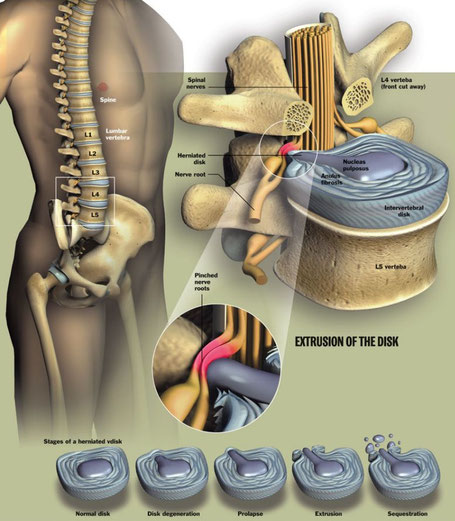Herniated /Slipped Disc

Herniations of spinal discs are very common in daily life and sporting injuries. The end result is the same but the cause varies depending on activity.
The intervertebral discs are the pivotal axis of movement for the spinal column and have fibers (roots) that join into the vertebrae above and below. The disc is made up of two components, the nucleus pulposus (center 1/3) and the annulus fibrosis (outer 2/3) .The nucleus pulposus is a soft jelly like substance. The outer annular fibers circulate the nucleus and act like rubber bands to provide a boundary wall for the disc. The disc provides shock absorption and the ability for the vertebrae above and below to move. However, the major role of the outer annular fibers is to restrict excessive rotation.
A herniated disc will therefore occur more often when the spinal column is stressed in forward flexion and rotation, tearing the outer fibers (annulus fibrosis) causing the central nucleus to protrude into the annular wall causing a ‘’protrusion or bulge’’. This protrusion will then possibly touch or compress the spinal nerve root and or the spinal cord producing moderate to severe pain. The degree of protrusion will determine the severity of the condition.
The symptoms experienced may include; numbness and tingling, burning, weakness, referred pain down the leg following the specific nerve affected as in sciatic neuralgia, and groin pain. If you have any problems with bowel and bladder function you must seek medical attention immediately.
CHIROPRACTOR TREATMENT
Specific examination and diagnostic principles are utilised including X-Rays and MRI Scans are in order to ensure patient safety, and a speedy resolution of your pain.
We treat the Mechanical Joint Dysfunction which can be the cause of the resultant pain pattern. X rays and MRI’s may be used to assist in the diagnosis if needed.
In order to effectively manage your condition, the Spine Clinic may also implement spinal stabilization exercises and massage therapy to address the muscle spasms.
The sooner you receive treatment the more successful the outcome.
